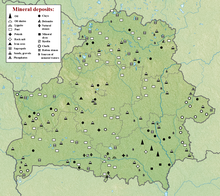This article needs additional citations for verification. (August 2018) |
The geology of Belarus began to form more than 2.5 billion years ago in the Precambrian, although many overlying sedimentary units deposited during the Paleozoic and the current Quaternary. Belarus is located in the eastern European plain. From east to west it covers about 650 kilometers while from north to south it covers about 560 kilometers, and the total area is about 207,600 square kilometers. It borders Poland in the north, Lithuania in the northwest, Latvia and Russia in the north, and Ukraine in the south. Belarus has a planar topography with a height of about 160 m above sea level. The highest elevation at 346 meters above sea level is Mt. Dzerzhinskaya, and the lowest point at the height of 80 m is in the Neman River valley.
The soils are soddy podzols and peat bogs are common. Belarus is situated on Cratons basement is made of Archean and early Proterozoic crystalline basement rocks and covered by terrigenous, volcanogenic, and carbonate rocks that date to the Riphean (a stratigraphic division of the Proterozoic in Russia and Scandinavia) through the last 2.5 million years of the Quaternary.[1]

- ^ Moores, E.M.; Fairbridge, Rhodes W. (1997). Encyclopedia of European & Asian Regional Geology. Springer. pp. 72–78.